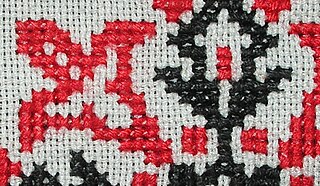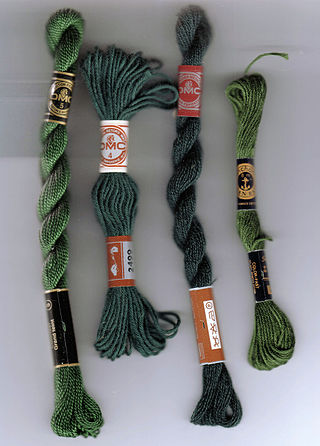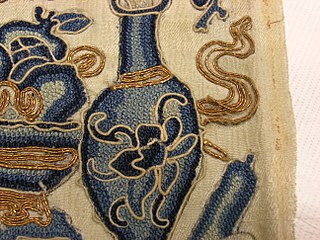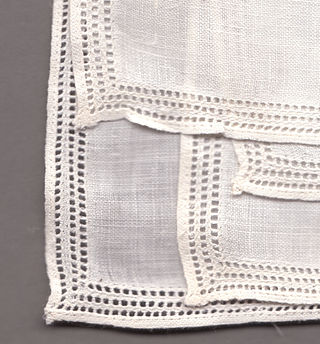

Embroidery hoops and frames are tools used to keep fabric taut while working embroidery or other forms of needlework.


Embroidery hoops and frames are tools used to keep fabric taut while working embroidery or other forms of needlework.
An embroidery hoop or (earlier) tambour frame consists of a pair of concentric circular or elliptical rings. The larger ring has a tightening device, usually in the form of a metal screw. The artisan repositions the hoop as needed when working over a large piece of fabric. Embroidery hoops come in various sizes and are generally small enough to control with one hand and rest in the lap. Hoops were originally made of wood, bone, or ivory; [1] modern hoops are made of wood or plastic. [2] Hoops may be attached to a table-top or floor stand when both hands must be free for sewing, as in making tambour lace. Standing floor frames and lap frames allow the crafter to keep both hands free for working, which increases the speed and precision of work performed. [3]
Some modern embroidery hoops, instead of having a tightening device, has a rubber band-style ring that fits over the fabric, and the smaller ring.
Very thin plastic hoops are also used in machine embroidery.

A scroll frame or embroidery frame keeps the entire piece of fabric taut, rather than just the piece being worked. It is made of four pieces of wood: two rollers for the top and base, and two side pieces. Each of the rollers has a piece of fabric securely nailed or stapled along it and holes in its ends to hold the side pieces, which can be secured in place with wing nuts to adjust the width of the frame and the tautness of the stretched fabric. The ends of the ground fabric are sewn to the rollers, which are turned until the area of the fabric to be worked is stretched within the frame. [1] [2]
Frames are used in needlepoint and other forms of canvas work as well as embroidery.

Embroidery is the art of decorating fabric or other materials using a needle to stitch thread or yarn. Embroidery may also incorporate other materials such as pearls, beads, quills, and sequins. In modern days, embroidery is usually seen on hats, clothing, blankets, and handbags. Embroidery is available in a wide variety of thread or yarn colour. It is often used to personalize gifts or clothing items.

Blackwork, sometimes historically termed Spanish blackwork, is a form of embroidery generally worked in black thread, although other colours are also used on occasion, as in scarletwork, where the embroidery is worked in red thread. Originating in Tudor period England, blackwork typically, though not always, takes the form of a counted-thread embroidery, where the warp and weft yarns of a fabric are counted for the length of each stitch, producing uniform-length stitches and a precise pattern on an even-weave fabric. Blackwork may also take the form of free-stitch embroidery, where the yarns of a fabric are not counted while sewing.

Appliqué is ornamental needlework in which pieces or patches of fabric in different shapes and patterns are sewn or stuck onto a larger piece to form a picture or pattern. It is commonly used as decoration, especially on garments. The technique is accomplished either by hand stitching or machine. Appliqué is commonly practised with textiles, but the term may be applied to similar techniques used on different materials. In the context of ceramics, for example, an appliqué is a separate piece of clay added to the primary work, generally for the purpose of decoration.

Crewel embroidery, or crewelwork, is a type of surface embroidery using wool. A wide variety of different embroidery stitches are used to follow a design outline applied to the fabric. The technique is at least a thousand years old.
Needlepoint is a type of canvas work, a form of embroidery in which yarn is stitched through a stiff open weave canvas. Traditionally needlepoint designs completely cover the canvas. Although needlepoint may be worked in a variety of stitches, many needlepoint designs use only a simple tent stitch and rely upon color changes in the yarn to construct the pattern. Needlepoint is the oldest form of canvas work.

Chain stitch is a sewing and embroidery technique in which a series of looped stitches form a chain-like pattern. Chain stitch is an ancient craft – examples of surviving Chinese chain stitch embroidery worked in silk thread have been dated to the Warring States period. Handmade chain stitch embroidery does not require that the needle pass through more than one layer of fabric. For this reason the stitch is an effective surface embellishment near seams on finished fabric. Because chain stitches can form flowing, curved lines, they are used in many surface embroidery styles that mimic "drawing" in thread.

Macramé is a form of textile produced using knotting techniques.

Darning is a sewing technique for repairing holes or worn areas in fabric or knitting using needle and thread alone. It is often done by hand, but using a sewing machine is also possible. Hand darning employs the darning stitch, a simple running stitch in which the thread is "woven" in rows along the grain of the fabric, with the stitcher reversing direction at the end of each row, and then filling in the framework thus created, as if weaving. Darning is a traditional method for repairing fabric damage or holes that do not run along a seam, and where patching is impractical or would create discomfort for the wearer, such as on the heel of a sock.

Backstitch or back stitch and its variants stem stitch, outline stitch and split stitch are a class of embroidery and sewing stitches in which individual stitches are made backward to the general direction of sewing. In embroidery, these stitches form lines and are most often used to outline shapes and to add fine detail to an embroidered picture. It is also used to embroider lettering. In hand sewing, it is a utility stitch which strongly and permanently attaches two pieces of fabric. The small stitches done back-and-forth makes the back stitch the strongest stitch among the basic stitches. Hence it can be used to sew strong seams by hand, without a sewing machine.
Surface embroidery is any form of embroidery in which the pattern is worked by the use of decorative stitches and laid threads on top of the foundation fabric or canvas rather than through the fabric; it is contrasted with canvas work.

A balanced fabric is one in which the warp and the weft are of the same size. In weaving, these are generally called "balanced plain weaves" or just "balanced weaves", while in embroidery the term "even-weave" is more common.

Hairpin lace is a lace-making technique that uses a crochet hook and two parallel metal rods held at the top and the bottom by removable bars. Historically, a metal U-shaped eponymous hairpin was used.

In sewing and embroidery, a satin stitch or damask stitch is a series of flat stitches that are used to completely cover a section of the background fabric. Narrow rows of satin stitch can be executed on a standard sewing machine using a zigzag stitch or a special satin stitch foot.

In embroidery, couching and laid work are techniques in which yarn or other materials are laid across the surface of the ground fabric and fastened in place with small stitches of the same or a different yarn.

Embroidery thread is yarn that is manufactured or hand-spun specifically for embroidery and other forms of needlework. Embroidery thread often differs widely, coming in many different fiber types, colors and weights.

Featherstitch or feather stitch and Cretan stitch or faggoting stitch are embroidery techniques made of open, looped stitches worked alternately to the right and left of a central rib. Fly stitch is categorized with the featherstitches.

A knotted stitch, also known as knot stitch, is any embroidery technique in which the yarn or thread is knotted around itself. A knotted stitch is a type of decorative embroidery stitches which form three-dimensional knots on the surface of a textile. Common knotted stitches include French knots, coral stitch, and Pekin knot which is sometimes also referred as French knot although there is a difference in techniques between these two stitches. Knotted stitches can be subdivided into individual or detached knots, continuous knotted stitches, and knotted edgings.

The straight or running stitch is the basic stitch in hand-sewing and embroidery, on which all other forms of sewing are based. The stitch is worked by passing the needle in and out of the fabric at a regular distance. All other stitches are created by varying the straight stitch in length, spacing, and direction.

In embroidery, plainweave is a technical category of woven base fabrics that are suitable for working certain varieties of embroidery. Plainweave fabrics have a tight weave and individual threads are not readily visible. Surface embroidery may be performed on plainweave, such as crewel work, goldwork, stumpwork, cutwork, and candlewicking.

Hemstitch or hem-stitch is a decorative drawn thread work or openwork hand-sewing technique for embellishing the hem of clothing or household linens. Unlike an ordinary hem, hemstitching can employ embroidery thread in a contrasting color so as to be noticeable.